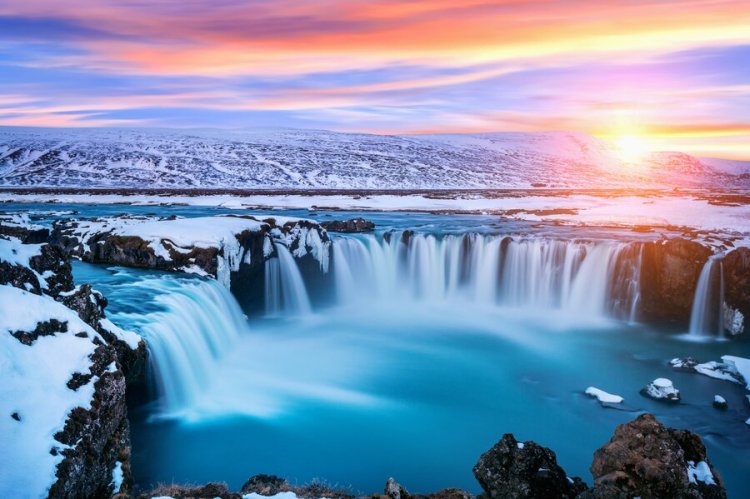5 famous waterfalls in Iceland
Share this Post to earn Money ( Upto ₹100 per 1000 Views )

Iceland, a land of fire and ice, is renowned for its stunning natural landscapes, including some of the world's most captivating waterfalls. These cascades, shaped by Iceland's volcanic terrain and glacial rivers, attract visitors from around the globe seeking the wonders of nature. Each waterfall in Iceland possesses its own unique charm and character, offering breathtaking views and unforgettable experiences. Among these, Gullfoss stands out with its powerful double cascade plunging into a rugged canyon, while Seljalandsfoss allows visitors to walk behind its shimmering curtain of water. Skógafoss impresses with its thunderous roar and panoramic vistas, while Dettifoss astonishes with its sheer volume and remote beauty. Lastly, Svartifoss captivates with its basalt column backdrop, creating a scene straight out of a fantasy. These waterfalls not only showcase Iceland's geological diversity but also its cultural and historical significance. From ancient legends to modern-day conservation efforts, Iceland's waterfalls are symbols of its natural heritage and enduring allure. Exploring these wonders reveals the power and beauty of nature in one of the world's most captivating destinations.
Here are some famous waterfalls in Iceland
1.Gullfoss: Gullfoss, which translates to "Golden Falls," is one of the most famous waterfalls in Iceland. Situated in the Hvítá river canyon in southwest Iceland, it is renowned for its striking twin cascades. The water plummets two levels, crashing into the small gorge below in a breathtaking spectacle. Gullfoss is well-known not only for its breathtaking beauty but also for its historical significance, having contributed to Iceland's early conservation efforts. Due to its proximity to the Golden Circle route, it is a well-liked travel destination for people looking for natural beauties.
2. Seljalandsfoss: Located in the southern part of Iceland, Seljalandsfoss is a remarkable waterfall that is well-known for allowing visitors to walk behind the gushing water. This waterfall plummets more than 60 meters from the surrounding rocks and is fed by the Seljalandsá River. Walking behind the waterfall offers guests a unique and captivating experience, letting them observe the world behind a watery curtain. Photographers and nature lovers find Seljalandsfoss to be especially attractive with the midnight sun, when the golden light accentuates its splendor.
3. Skógafoss: Situated southwards along the Skógá River in Iceland is another magnificent waterfall, Skógafoss. One of Iceland's biggest waterfalls, it plunges over 60 meters and is 25 meters wide. Skógafoss is unique because of its strong water curtain, which, when it falls into the pool below, produces an enthralling mist. A staircase next to the waterfall allows visitors to ascend for a broad perspective of the surroundings, which on clear days includes views of the Atlantic Ocean and glaciers. An additional fascination with Skógafoss is the legend that it is surrounded by a hidden treasure.
4. Dettifoss: The strongest waterfall in Europe, Dettifoss, is found in Vatnajökull National Park in northeastern Iceland. It is well known for its overwhelming strength and volume as it descends more than 44 meters into the Jökulsárgljúfur canyon. The spectacular effect of Dettifoss is heightened by the milky glacial waters of the Jökulsá á Fjöllum river, which roars with a thunderous sound that is audible from a great distance. Adventurers and nature enthusiasts drawn to Iceland by its untamed beauty are drawn to its harsh and remote location, which contributes to its allure.
5. Svartifoss: Svartifoss, which translates as "Black Falls," is a magnificent waterfall found in southeast Iceland's Skaftafell, which is a component of Vatnajökull National Park. Svartifoss is distinguished by its dramatic and unusual backdrop of basalt columns that resemble organ pipes. Lava slowly cooled over time to form these hexagonal columns, which provide a lovely natural framing that contrasts with the white water falling below. One of the most popular stops for hikers visiting Iceland's varied landscapes is the climb to Svartifoss, which winds through a lush canyon and gives breathtaking views of numerous waterfalls and geological formations.
Conclusion
In conclusion, the famous waterfalls of Iceland offer a glimpse into the country's remarkable natural beauty and geological wonders. Each waterfall, from the majestic Gullfoss to the mystical Svartifoss, leaves a lasting impression on visitors, showcasing Iceland's unique landscape shaped by volcanic activity and glacial forces. These waterfalls not only attract tourists seeking adventure and stunning photography opportunities but also play a significant role in Iceland's tourism industry and environmental conservation efforts. They serve as reminders of the country's rich cultural heritage and its deep connection to nature. For travelers planning to visit Iceland, obtaining an Iceland visa is essential. It allows visitors to explore these magnificent waterfalls and other natural attractions in a country known for its pristine landscapes and friendly hospitality. Whether it's the thundering power of Dettifoss or the ethereal beauty of Seljalandsfoss, Iceland's waterfalls offer experiences that inspire and rejuvenate, making them must-see destinations for anyone venturing into the land of fire and ice. Visiting Iceland's waterfalls is not just about witnessing natural wonders but also about connecting with the raw power and serene beauty of the country's untouched landscapes, leaving visitors with memories that last a lifetime.
Read More





